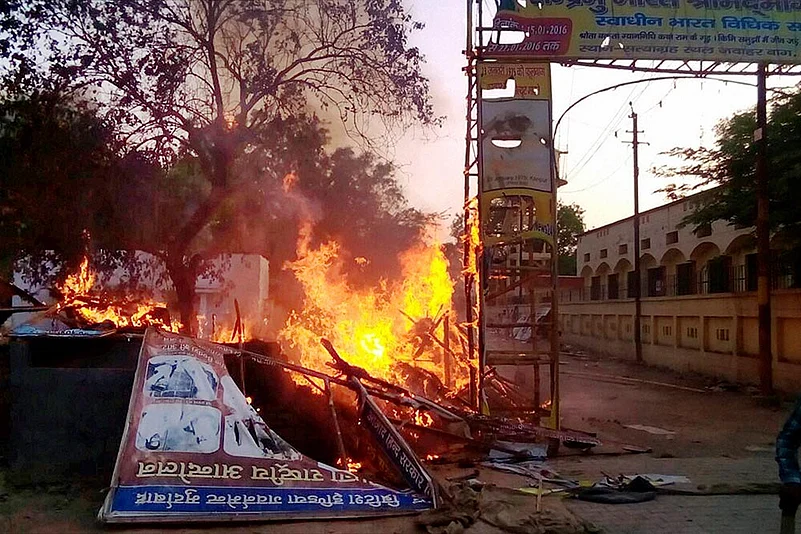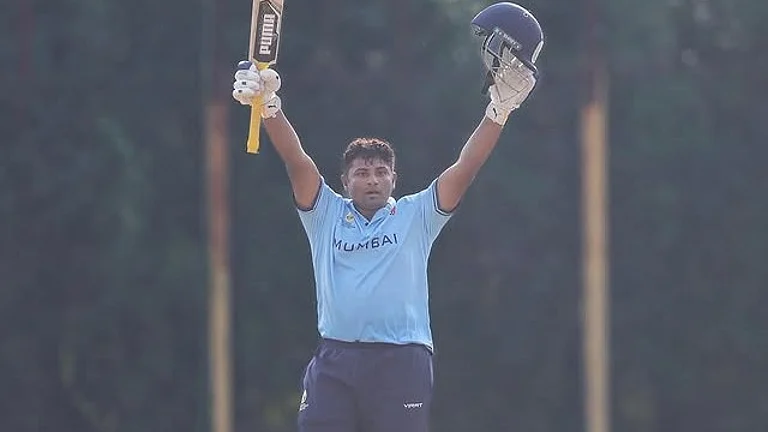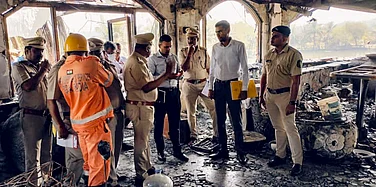Until recently, residents around Jawahar Bagh in Mathura didn’t have much of a problem with the few thousand squatters who had taken over the park some two years ago. They didn’t mind entering personal details in a register to enter the park for buying seasonal vegetables at a third of the market price, sugar for Rs 15 a kilo sugar and potatoes for Rs 10. Only children from the neighbouring police lines were allowed to scale the wall to pick up fruit that fell from the trees.
However, the authorities in this temple town of 3.5 lakh population, some 140 km from Delhi, had been suspicious all along. Tension had been rising over the past few months, with the authorities trying to glean more information on what the squatters—called everything from “religious Naxals” (IGP Durga Charan Mishra) to anarchists, “cultists” and troublemakers—were up to.
In the past two years, residents of Jawahar Bagh colony, the police lines, the prison staff colony and the judges colony had synchronised their morning schedules to the 8 am prayer that wafted across the six-foot wall of the 260-acre garden into their homes. “That would tell us whether we were running late or not,” recalls Kanchan Yadav of Jawahar Bagh colony.
On the other side of the wall is the park curated by the horticultural department that the squatters had turned into a “commune”. Claiming to be inspired by Subhash Chandra Bose, Ram Vriksh Yadav, founder-leader of the Swadhin Bharat Vidhik Satyagrah (SBVS), was running the setup as “his own little republic”, say officials. The “commune” had its own rules, security, school and even an adjudication system for members’ lapses.
On June 2, Yadav’s body was found among the 29 dead in the police operation on June 2 to evict the squatters. Two police officers were also killed—SP (Mathura city) Mukul Dwivedi, who led the posse of policemen, including many trainees, was bludgeoned to death and the local SHO, Shrikant Sharma, shot from close range. The police firing is said to have continued for around 90 minutes. And a fire raged in the park all through the night, with gas cylinders exploding intermittently. Around 320 squatters were arrested but over thrice more are said to have fled the spot.
The news of the deaths in the park triggered outrage and the Uttar Pradesh government ordered a judicial inquiry into this bizarre police operation, much about which remains shrouded in mystery.
For the record, the police had gone to the park to persuade over 1,000 squatters to leave, as the Allahabad High Court, hearing a PIL, had ordered their eviction. This was not the first time an attempt was being made. The narrative then proceeds to the police coming under attack and retaliating in “self-defence”. As evidence, besides two dead officers and some injured men, there were recoveries of explosives, 52 firearms and cartridges (85 live and 99 spent).
The park is in the middle of the Mathura cantonment. Across its western boundary are a military helipad and a prison. The gate on the opposite side is flanked by the SP (City)’s office and the Collectorate. Across the road is the district court.
Every morning, after prayers, Yadav used sit down for a breakfast meeting with his lieutenants—Chandan Bose, Rakesh Gupta, Ram Shiromal, Phoolchand Patel and Harnath Singh—to discuss the day’s work. Then there would be an assembly involving all residents. This would also be the occasion to hand out sentences for ‘offences’ such as missing prayers. The organisation had also converted the horticulture department’s offices in the park for the commune’s use. Yadav is said to have taken over the only air-conditioned room for his own use.

The ‘commune’
The SBVS was contemplating its own constitution for the country, new laws and currency issued by Netaji’s pre-independence Azad Hind Bank. And they aimed at making each rupee fetch 60 litres of diesel , 40 of petrol or 12 tolas of gold.
Post-assembly, the children would attend ‘school’ while others did various chores. At school, the children performed drills, shouted “Azad Hind” slogans and were taught their version of political history.
Come afternoon, every resident would line up with a steel plate, bowl and a water bottle. That was all their personal possessions, besides some clothes, personal effects and identity cards. Only a select few were allowed to keep cellphones; others could use them under “supervision” to make short-duration calls. A trip out of the park meant arranging for temporary permits by convincing two other residents to take responsibility for their timely return.
The “cult” attracted a motley crowd—devotees of the deceased ‘Jai Gurudev’ (Tulsidas Malhar), agricultural labourers aspiring for a better life, poor villagers in search of food and shelter, disgruntled citizens looking for revolutionary change, abandoned senior citizens, people awaiting Netaji’s return. They made up the “commune” that was broken up in the bloodshed last Thursday, almost 26 months after the occupation of the park.
“We hadn’t planned to attack them,” says IGP Mishra. “We believe many people were being held against their will. To help them flee, the police demolished a part of the wall. The SP approached the squatters only to inform them of the court’s order and warn that force may have to be used eventually.”
Earlier, there had been some altercations between the squatters and the authorities, besides some run-INS with lawyers of the district court across the road, follwing which SBVS had increased security along the wall and near the gate. On seeing any official, the police claim, the guards’ number would go up from 15 to around 100.
When the SP led his team into the park through the breach in the wall, the people inside objected. The police say that is when they assaulted the SP and killed him. The SHO too took a bullet and died. When the police returned fire, the squatters ran back into the camp and allegedly set it on fire.
So how did the camp manage to remain in place for 26 months despite weapons being smuggled in? There have been claims that the state government had asked the district administration in 2014 not just to allow the camp to come up, but also to supply them with free electricity, water and also the rations that the squatters then sold at subsidised rates to locals. The administration was also allegedly instructed to turn a blind eye to the eviction of horticulture department officials and their families from the barracks in the park. Now, most people blame the administration for the deaths of the two policemen and their families have demanded court-monitored probes.
The smell of burnt flesh and trees and rotting grain envelops the site. The police hurriedly removed the gas cylinders provided by the administration, which had caught fire during the clash, and removed much of the evidence before allowing the media inside. Near the breach in the wall is the spot where the SHO was shot dead. A policeman stationed there points at a dent on a tree, saying it was made by a bullet fired by the squatters. However, the mark appears to be one that could have been made only by a bullet fired from outside.
The police refused permission to meet the injured squatters. At the Mathura district hospital, Outlook managed to speak briefly with Ram Sharan Yadav (not related to the outfit’s founder) before he was hurriedly wheeled away on a gurney.
A bullet had entered his gut and exited through his back. A saline drip and a catheter attached to his body, he said a friend “misguided” him and he had been forcibly held at the camp. “Can you help me return to Gorakhpur?” sobbed the 20-something agricultural labourer.
By Ushinor Majumdar in Mathura and Agra


























